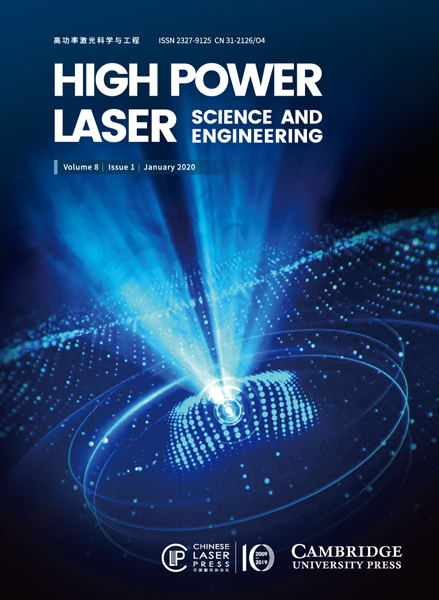HPL Highlights (e32): 探索光谱更高精度:新型中红外光梳
探索光谱更高精度:新型中红外光梳
作为可以测量绝对光学频率的标尺,频率梳彻底改变了光谱学的精度。为了提高光梳光谱的灵敏度,中红外光梳成为近年来的研究热点,而中红外光源的频率控制是获得高精度光梳光谱的前提条件。
现在有许多新的方法来产生相干中红外激光光源,但在检测和控制中红外光源的频率时相对来说更加困难,更直接的方法是基于可见光或近红外波段的激光,利用超短脉冲的非线性频率转换将波段拓展至中红外,产生相干的中红外光源。差频可以使用紧凑和成熟的光纤激光器产生中红外超短脉冲,实现载波包络相位稳定,结构简单,长期稳定性好。
差频产生的中红外光梳梳齿线宽与种子源的相位噪声有关,因此两个低相噪的近红外光梳光源是实现高分辨率中红外双光梳光谱的基础。虽然现在有很多超低噪声近红外振荡器,但是放大和差频过程引入额外的相位噪声仍然会导致中红外光梳的梳齿变宽。
华东师范大学李文雪研究员课题组对基于差频产生的中红外光梳的噪声源进行了研究,报道了一种基于近红外系统的中红外光梳。研究成果发表于High Power Laser Science and Engineering 2020年第4期(Lian Zhou, Yang Liu, Gehui Xie, et al. Mid-infrared optical frequency comb in the 2.7–4.0 μm range via difference frequency generation from a compact laser system[J]. High Power Laser Science and Engineering, 2020, 8(4): 04000e32)。
该近红外系统包括一个掺镱光纤光梳种子源和掺镱光纤啁啾脉冲放大器,该系统可以输出4 W、194 fs的近红外激光脉冲,分为两束,分别作为信号光和泵浦光。将信号光耦合至反常色散的高非线性光子学晶体光纤中,光谱被非线性展宽。然后将信号光和泵浦光合束并聚焦到周期性极化的铌酸锂中进行差频产生中红外光梳,其光谱可调谐范围为2.7-4.0 μm,最大平均功率为250 mW。
作者还测量了各模块的噪声,分析了噪声源,对无载波包络相位偏移的中红外光梳系统的重复频率相位噪声进行了测量和分析。结果表明除近红外梳齿固有噪声外,低频环境噪声和高频量子噪声以及非线性展宽过程是中红外梳齿线变宽的主要噪声来源。
李文雪研究员认为,这项工作有助于开发低噪声中红外光梳光谱学以及发展高精度双光梳光谱学。

差频产生中红外光梳示意图
Mid-infrared comb generation via difference frequency generation
An optical frequency comb can be used as an optical ruler for the measurement of absolute optical frequencies. The precision of spectroscopy has been revolutionized using comb technology. To improve the comb spectroscopy sensitivity, using mid-infrared combs has become popular in recent years because of strong vibrational absorption in the mid-infrared region.
There is a wide array of innovative solutions to generate coherent mid-infrared laser sources, with novel gain media, quantum cascade lasers, and micro-resonator, supercontinuum generation in the waveguides and the fibers. Compared with these approaches, detecting and controlling the offset frequency of mid-infrared sources is a challenging work, which is the prerequisite for frequency comb spectroscopy.
A more direct approach is to employ nonlinear frequency conversion of ultrashort pulses in visible or near-IR regime to generate coherent mid-infrared sources. Difference frequency generation (DFG) employing signal and pump delivered from the same oscillator offers several advantages for a mid-infrared frequency comb system. It allows us to use compact and well-developed fiber laser technology and to achieve ultrashort pulses and intrinsic carrier-envelope phase stability. Moreover, this approach reduces complexity and improves quality of long-term performance. The linewidth of mid-infrared comb generated by DFG is related to the near-infrared source' s phase noise.
Compared to the mid-infrared combs, the near-infrared combs are easier to measure and control phase noise. Therefore, low phase noise of two near-infrared sources is fundamental to achieve high-resolution dual-comb spectroscopy. Various ultralow-noise near-infrared oscillators have been demonstrated. Excess phase noise from near-infrared amplification and DFG process will lead to linewidth broadening of the mid-infrared comb.
The group led by Prof. Wenxue Li from East China Normal University researched noise source of DFG-based mid-infrared comb. The research results are published in High Power Laser Science and Engineering 8(4), e32, 2020 (Lian Zhou, Yang Liu, Gehui Xie, et al. Mid-infrared optical frequency comb in the 2.7–4.0 μm range via difference frequency generation from a compact laser system[J]. High Power Laser Science and Engineering, 2020, 8(4): 04000e32).
The article reports on a mid-infrared comb based on a near-infrared system. The near-infrared system included an Yb:fiber comb and an Yb fiber chirped-pulse amplifier emits a pulse train with a 4-W average power and a 194-fs pulse duration. The near-infrared source is spilt into two beams as signal and pump pulse of DFG.
The spectrum of signal pulse is nonlinearly broadened in highly nonlinear photonics crystal fiber with anomalous dispersion. The pump and signal pulse are focused into a periodically poled lithium niobate for DFG. The mid-IR comb has a tunable spectrum from 2.7 μm to 4.0 μm and a maximum average power of 250 mW. Authors measured noise of each module and analyzed noise source. The phase noise of repetition rate in the offset-free mid-IR comb system is measured and analyzed.
Except for the intrinsic of NIR comb, environmental noise at low frequency and quantum noise at high frequency from the amplifier chain and nonlinear spectral broadening are the main noise source of broadening the linewidth of comb teeth. Prof. Wenxue Li believes that this work is potential to develop low-noise mid-infrared combs and high-coherence dual-comb spectroscopy.

Mid-infrared comb generation via difference frequency generation.
动态信息
激光评论微信公众号

点击菜单“联系编辑”即可添加期刊编辑为好友啦


